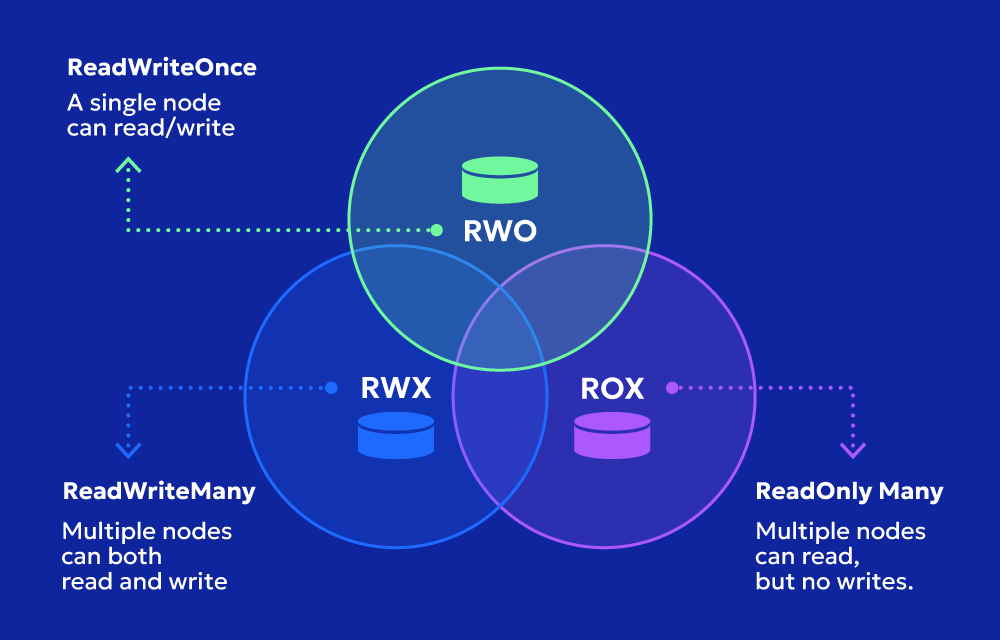What Are PVC AccessModes in Kubernetes?
AccessModes determine the level of sharing allowed for a Persistent Volume across multiple Pods. Kubernetes supports the following AccessModes:
- ReadWriteOnce (RWO)
- The volume can be mounted as read-write by a single node.
- Even if multiple Pods run on the same node, they can share the volume, but Pods on different nodes cannot.
- Commonly used for block storage solutions like Amazon EBS, Google Persistent Disk, or Azure Disk.
- ReadOnlyMany (ROX)
- The volume can be mounted as read-only by multiple nodes.
- Suitable for cases where the same dataset needs to be accessed without modification.
- Typically used for shared filesystems like NFS (Network File System).
- ReadWriteMany (RWX)
- The volume can be mounted as read-write by multiple nodes.
- Enables concurrent read/write access from multiple Pods across different nodes.
- Often used for shared network storage like NFS, CephFS, or GlusterFS.
- ReadWriteOncePod (RWOP) [Kubernetes 1.22+]
- The volume can be mounted as read-write by only one Pod at a time.
- Ensures exclusive use of storage for a single Pod, preventing conflicts in applications requiring dedicated access.
- Supported by some storage providers that enforce strict single-Pod access.
How to Select the Right AccessMode?
To choose the appropriate AccessMode for your Kubernetes workload, consider the following factors:
- Application Requirements: Determine whether your application needs shared or exclusive storage access. Databases typically require ReadWriteOnce (RWO) for stability, while logging or shared file storage solutions benefit from ReadWriteMany (RWX).
- Storage Type: Identify the underlying storage system. Block storage solutions like AWS EBS, Google Persistent Disk, and Azure Disk usually support RWO, whereas network file systems like NFS and CephFS support RWX.
- Cluster Architecture: If your application runs across multiple nodes and requires shared access, RWX is the best option. If only one node needs access but with multiple Pods, RWO suffices.
- Performance Considerations: If high performance and low latency are required, block storage with RWO might be the optimal choice. For cost-effective shared storage, RWX via NFS or CephFS works well.
- Security and Isolation: For workloads requiring strict isolation (e.g., sensitive data applications), ReadWriteOncePod (RWOP) ensures a single Pod has exclusive access to a volume at any time.
OpenShift PVC AccessModes
OpenShift, which is built on Kubernetes, follows the same PVC AccessModes but introduces additional considerations:
- RWX Support: OpenShift’s default storage providers, such as OpenShift Container Storage (OCS), support RWX more efficiently using CephFS.
- Dynamic Provisioning: OpenShift integrates seamlessly with dynamic storage provisioning, automatically assigning PVCs based on defined StorageClasses.
- Security Context Constraints (SCCs): OpenShift enforces stricter security policies that may influence PVC mounting behavior, requiring additional configurations.
Example: PVC Manifest with AccessModes
Below is an example of a Kubernetes PVC manifest specifying the ReadWriteMany (RWX) AccessMode:
apiVersion: v1
kind: PersistentVolumeClaim
metadata:
name: shared-pvc
spec:
accessModes:
- ReadWriteMany
resources:
requests:
storage: 10Gi
storageClassName: nfs-storage
In OpenShift, a similar definition would work, but the storage class might be ocs-storagecluster-cephfs for CephFS-backed RWX support.
Common Use Cases
| AccessMode | Common Use Cases |
|---|---|
| RWO | Databases, Single-node applications |
| ROX | Shared documentation repositories |
| RWX | Logging systems, Shared volumes between microservices |
| RWOP | Stateful applications requiring exclusive access |
Conclusion
Understanding PVC AccessModes in Kubernetes is essential for ensuring optimal storage performance and application reliability. While Kubernetes provides multiple options, OpenShift enhances storage flexibility with additional security and provisioning mechanisms. Choosing the right AccessMode depends on application needs, storage backend capabilities, and cluster architecture, making it crucial to align these factors when designing Kubernetes storage solutions.



